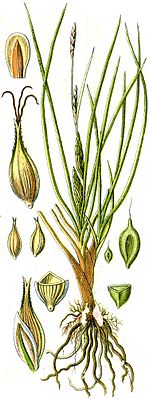Barley sedge
| Barley sedge | ||||||||||||
|---|---|---|---|---|---|---|---|---|---|---|---|---|

Barley sedge ( Carex hordeistichos ), illustration |
||||||||||||
| Systematics | ||||||||||||
|
||||||||||||
| Scientific name | ||||||||||||
| Carex hordeistichos | ||||||||||||
| Vill. |
The barley sedge ( Carex hordeistichos ) is a species of sedge ( Carex ) native to Central Europe . It is a variegated sedge.
description
The whip sedge is a perennial plant and grows prostrate to ascending. It becomes 10 to 30 (rarely 50) cm high. The stems are thick, smooth and bluntly triangular. The leaves are 3 to 5 mm wide, stiff leathery and simply runny. At the edge they are rough and they are much longer than the stem. The basal leaf sheaths are yellow to black-brown and fibrous.
There are usually two or three male spikelets . They are closer to each other, but removed from the feminine ones. There are three to four female spikelets. These are densely flowered, ovate to oblong and 8 to 10 mm thick. The upper spikelets are brought closer together, the lower one is distant. The bracts are long sheathed, large and protrude beyond the stem.
The bracts are light brown, have a white skin edge and are broadly ovate, pointed and shorter than the fruit. The stylus has three scars . Flowering time is May to July.
The fruits are sometimes over 1 cm long, they are in four or five clear lines. They are straw yellow, shiny and bald, with rough edges. The beak is two-toothed. The pericarp is spongy.
The number of chromosomes is 2n = 56 or 60.
distribution
The species is native to Europe as far as Iran and North Africa and is a meridional to subtemperate, subcontinental flora element. The main distribution area of the species is in southwest Siberia and in southern Europe (to the eastern Mediterranean and southern France).
Locations and distribution in Central Europe
The barley sedge needs loose soil, which may contain a bit of saline, in a warm and air-dry area in summer. She therefore avoids coasts. It grows in meadows, ditches, on paths, on salty, moist and nutrient-rich soils. It only occurs up to the submontane altitude level . It is a character species of Juncetum compressi from the Agropyro-Rumicion association.
It is very rare in Central Europe ; it probably only occurs in the Wetterau , in Saxony-Anhalt between Bode and Saale , in Thuringia in the Gera-Unstrut lowlands as well as in the Vienna Basin and in Burgenland.
literature
- Rudolf Schubert , Klaus Werner, Hermann Meusel (eds.): Excursion flora for the areas of the GDR and the FRG . Founded by Werner Rothmaler. 13th edition. tape 2 : vascular plants . People and knowledge, Berlin 1987, ISBN 3-06-012539-2 (area).
- Siegmund Seybold (Ed.): Schmeil-Fitschen interactive . CD-ROM, version 1.1. Quelle & Meyer, Wiebelsheim 2002, ISBN 3-494-01327-6 .
- Dietmar Aichele, Heinz-Werner Schwegler: The flowering plants of Central Europe , Franckh-Kosmos-Verlag, 2nd revised edition 1994, 2000, volume 5, ISBN 3 440-08048-X
Individual evidence
- ↑ a b Erich Oberdorfer : Plant-sociological excursion flora for Germany and neighboring areas . 8th edition. Stuttgart, Verlag Eugen Ulmer, 2001. ISBN 3-8001-3131-5 . Page 192.
- ↑ Rafaël Govaerts (ed.): Carex hordeistichos. In: World Checklist of Selected Plant Families (WCSP) - The Board of Trustees of the Royal Botanic Gardens, Kew . Retrieved October 21, 2016.
Web links
- Barley sedge. In: FloraWeb.de.
- Barley sedge . In: BiolFlor, the database of biological-ecological characteristics of the flora of Germany.
- Profile and distribution map for Bavaria . In: Botanical Information Hub of Bavaria .
- Thomas Meyer: Data sheet with identification key and photos at Flora-de: Flora von Deutschland (old name of the website: Flowers in Swabia )
Photos: